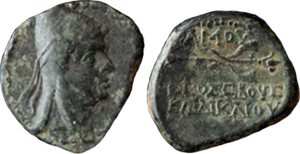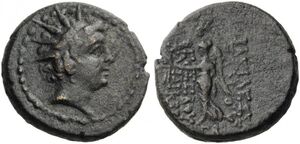Samos c.130-100 BC (Kov 219-220)
Description
Samos Theosebes Dikaios (BNP [2]) was the great-grandson of Samos, king of Sophene (ca. 275—ca. 255 BC), son of Ptolemaios (BNP 12, 942), the father of Mithradates I, and grandfather of Antiochus I.
Samos's coins are unusual for several reasons. On the obverse of the four chalkous an incuse palm branch which appears at first glance to be a countermark, is actually part of the die. The use of relief and incuse elements on the same die can be seen on Persian period Phoenician silver coins but is otherwise an extremely rare engraving technique. Further, the image on the obverse of the two chalkous is generally described as Samos as Helios. This seems a daring guise for a king calling himself "god-fearing." A more likely interpretation is that Samos is shown wearing the headdress of the high priest of Helios.
A final point of interest are the letters ΓΛ in the exergue of the dichalkon, which suggests either a control mark or a date. Given the letters FA, a date would be far more likely. Assuming an era of the independence of Commagene ca. 163 BC (see above), year 33 would probably date this issue to Samos's first year.
Kovacs, Frank L. “Armenian Coinage in the Classical Period” CNS 10, Classical Numismatic Group, Lancaster, 2016, pp. 39.
Samos's coins are unusual for several reasons. On the obverse of the four chalkous an incuse palm branch which appears at first glance to be a countermark, is actually part of the die. The use of relief and incuse elements on the same die can be seen on Persian period Phoenician silver coins but is otherwise an extremely rare engraving technique. Further, the image on the obverse of the two chalkous is generally described as Samos as Helios. This seems a daring guise for a king calling himself "god-fearing." A more likely interpretation is that Samos is shown wearing the headdress of the high priest of Helios.
A final point of interest are the letters ΓΛ in the exergue of the dichalkon, which suggests either a control mark or a date. Given the letters FA, a date would be far more likely. Assuming an era of the independence of Commagene ca. 163 BC (see above), year 33 would probably date this issue to Samos's first year.
Kovacs, Frank L. “Armenian Coinage in the Classical Period” CNS 10, Classical Numismatic Group, Lancaster, 2016, pp. 39.


